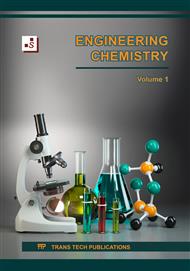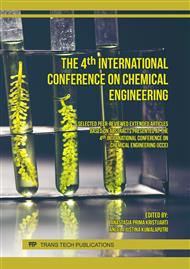[1]
F. M. Liew, M. E. Martin, R. C. Tappel, B. D. Heijstra, C. Mihalcea, and M. Köpke, "Gas Fermentation-A flexible platform for commercial scale production of low-carbon-fuels and chemicals from waste and renewable feedstocks," Front. Microbiol., vol. 7, no. MAY, 2016.
DOI: 10.3389/fmicb.2016.00694
Google Scholar
[2]
Y. Sun and J. Cheng, "Hydrolysis of lignocellulosic materials for ethanol production: A review," Bioresour. Technol., vol. 83, no. 1, p.1–11, 2002.
DOI: 10.1016/S0960-8524(01)00212-7
Google Scholar
[3]
T. D. Foust, A. Aden, A. Dutta, and S. Phillips, "An economic and environmental comparison of a biochemical and a thermochemical lignocellulosic ethanol conversion processes," Cellulose, vol. 16, no. 4, p.547–565, 2009.
DOI: 10.1007/s10570-009-9317-x
Google Scholar
[4]
M. Devarapalli, H. A.-B. R. Journal, and U. 2015, "A review of conversion processes for bioethanol production with a focus on syngas fermentation," Biofuel Res. J., vol. 7, p.268–280, 2015, Accessed: Feb. 07, 2020. [Online]. Available: http://biofueljournal.com/article_10157_0.html
DOI: 10.18331/brj2015.2.3.5
Google Scholar
[5]
M. P. García-Aparicio, I. Ballesteros, A. González, J. M. Oliva, M. Ballesteros, and M. J. Negro, "Effect of Inhibitors Released During Steam-Explosion Pretreatment of Barley Straw on Enzymatic Hydrolysis," in Twenty-Seventh Symposium on Biotechnology for Fuels and Chemicals, Humana Press, 2007, p.278–288.
DOI: 10.1007/978-1-59745-268-7_22
Google Scholar
[6]
D. W. Griffin and M. A. Schultz, "Fuel and chemical products from biomass syngas: A comparison of gas fermentation to thermochemical conversion routes," Environ. Prog. Sustain. Energy, vol. 31, no. 2, p.219–224, Jul. 2012.
DOI: 10.1002/EP.11613
Google Scholar
[7]
P. C. Munasinghe and S. K. Khanal, "Biomass-derived syngas fermentation into biofuels: Opportunities and challenges," Bioresource Technology, vol. 101, no. 13. p.5013–5022, Jul. 2010.
DOI: 10.1016/j.biortech.2009.12.098
Google Scholar
[8]
J. Philips, K. Rabaey, D. R. Lovley, and M. Vargas, "Biofilm formation by clostridium ljungdahlii is induced by sodium chloride stress: Experimental evaluation and transcriptome analysis," PLoS One, vol. 12, no. 1, Jan. 2017.
DOI: 10.1371/journal.pone.0170406
Google Scholar
[9]
K. Liu, H. K. Atiyeh, R. S. Tanner, M. R. Wilkins, and R. L. Huhnke, "Fermentative production of ethanol from syngas using novel moderately alkaliphilic strains of Alkalibaculum bacchi," Bioresour. Technol., vol. 104, p.336–341, 2012.
DOI: 10.1016/j.biortech.2011.10.054
Google Scholar
[10]
H. L. Drake, A. S. Gößner, and S. L. Daniel, "Old acetogens, new light," Ann. N. Y. Acad. Sci., vol. 1125, p.100–128, 2008.
DOI: 10.1196/annals.1419.016
Google Scholar
[11]
J. Daniell, M. Köpke, and S. D. Simpson, "Commercial biomass syngas fermentation," Energies, vol. 5, no. 12. MDPI AG, p.5372–5417, 2012.
DOI: 10.3390/en5125372
Google Scholar
[12]
Y. Jiang et al., "Consolidated bioprocessing of butanol production from xylan by a thermophilic and butanologenic Thermoanaerobacterium sp. M5," Biotechnol. Biofuels, vol. 11, no. 1, p.1–14, 2018.
DOI: 10.1186/s13068-018-1092-1
Google Scholar
[13]
K. T. Klasson, M. D. Ackerson, E. C. Clausen, and J. L. Gaddy, "Biological conversion of coal and coal-derived synthesis gas," Fuel, vol. 72, no. 12, p.1673–1678, 1993.
DOI: 10.1016/0016-2361(93)90354-5
Google Scholar
[14]
M. L. Shuler and F. Kargi, Bioprocess engineering: Basic concepts, Second. Upper Saddle River: Pretince-Hall, Inc, 2002.
Google Scholar
[15]
J. Li, C. Li, C. Q. Lan, and D. Liao, "Effects of sodium bicarbonate on cell growth, lipid accumulation, and morphology of Chlorella vulgaris," Microb. Cell Fact., vol. 17, no. 1, p.1–10, 2018.
DOI: 10.1186/s12934-018-0953-4
Google Scholar
[16]
M. D. Rolfe et al., "Lag phase is a distinct growth phase that prepares bacteria for exponential growth and involves transient metal accumulation," J. Bacteriol., vol. 194, no. 3, p.686–701, 2012.
DOI: 10.1128/JB.06112-11
Google Scholar
[17]
M. Yasin, M. Cha, I. S. Chang, H. K. Atiyeh, P. Munasinghe, and S. K. Khanal, Syngas fermentation into biofuels and biochemicals, 2nd ed. Elsevier Inc., 2019.
DOI: 10.1016/b978-0-12-816856-1.00013-0
Google Scholar
[18]
J. Saxena and R. S. Tanner, "Effect of trace metals on ethanol production from synthesis gas by the ethanologenic acetogen, Clostridium ragsdalei," J. Ind. Microbiol. Biotechnol., vol. 38, no. 4, p.513–521, 2011.
DOI: 10.1007/s10295-010-0794-6
Google Scholar
[19]
J. Saxena and R. Tanner, "Optimization of a corn steep medium for production of ethanol from synthesis gas fermentation by Clostridium ragsdalei," World J. Microbiol. Biotechnol., vol. 28, no. 4, p.1553–1561, Apr. 2012.
DOI: 10.1007/S11274-011-0959-0
Google Scholar
[20]
Y. Shen, R. Brown, Z. W.-A. Energy, and U. 2017, "Syngas fermentation by Clostridium carboxidivorans P7 in a horizontal rotating packed bed biofilm reactor with enhanced ethanol production," Elsevier, 2017, Accessed: Feb. 07, 2020. [Online]. Available: https://www.sciencedirect.com/science/article/pii/S0306261916317159
DOI: 10.1016/j.apenergy.2016.11.084
Google Scholar
[21]
Y. F. Han, B. T. Xie, G. X. Wu, Y. Q. Guo, D. M. Li, and Z. Y. Huang, "Combination of Trace Metal to Improve Solventogenesis of Clostridium carboxidivorans P7 in Syngas Fermentation," Front. Microbiol., vol. 11, no. September, p.1–12, 2020.
DOI: 10.3389/fmicb.2020.577266
Google Scholar
[22]
J. R. Phillips et al., "Butanol and hexanol production in Clostridium carboxidivorans syngas fermentation: Medium development and culture techniques," Bioresour. Technol., vol. 190, p.114–121, Aug. 2015.
DOI: 10.1016/J.BIORTECH.2015.04.043
Google Scholar
[23]
S. Park, B. Ahn, and Y. K. Kim, "Growth enhancement of bioethanol-producing microbe Clostridium autoethanogenum by changing culture medium composition," Bioresour. Technol. Reports, vol. 6, no. March, p.237–240, 2019.
DOI: 10.1016/j.biteb.2019.03.012
Google Scholar
[24]
S. Sertkaya, N. Azbar, H. N. Abubackar, and T. K. Gundogdu, "Design of low-cost ethanol production medium from syngas: An optimization of trace metals for clostridium ljungdahlii," Energies, vol. 14, no. 21, 2021.
DOI: 10.3390/en14216981
Google Scholar
[25]
I. Anggraini, M. Tri Ari Penia Kresnowati, R. Purwadi, and T. Setiadi, "Bioethanol Production via Syngas Fermentation," MATEC Web Conf., vol. 156, p.1–6, 2018.
DOI: 10.1051/matecconf/201815603025
Google Scholar
[26]
M. Mann et al., "Impact of different trace elements on metabolic routes during heterotrophic growth of C. ljungdahlii investigated through online measurement of the carbon dioxide transfer rate," Biotechnol. Prog., vol. e3263, 2022.
DOI: 10.1002/btpr.3263
Google Scholar
[27]
J. Seravalli et al., "Evidence that NiNi Acetyl-CoA Synthase Is Active and that the CuNi Enzyme Is Not," Biochemistry, vol. 43, no. 13, p.3944–3955, 2004.
DOI: 10.1021/bi036194n
Google Scholar
[28]
H. L. Drake, K. Küsel, and C. Matthies, Acetogenic prokaryotes. 2006.
DOI: 10.1007/0-387-30742-7_13
Google Scholar
[29]
M. Mohammadi, H. Younesi, G. Najafpour, and A. R. Mohamed, "Sustainable ethanol fermentation from synthesis gas by Clostridium ljungdahlii in a continuous stirred tank bioreactor," J. Chem. Technol. Biotechnol., vol. 87, no. 6, p.837–843, Jun. 2012.
DOI: 10.1002/jctb.3712
Google Scholar



